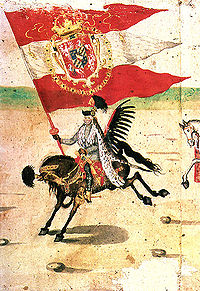
Standard-bearer (Polish: Chorąży [xɔˈrɔ̃ʐɨ]; Russian and Ukrainian: хорунжий, khorunzhiy; Lithuanian: chorunžis; Belarusian: харунжы, romanized: kharunzhy) is a military rank in Poland, Ukraine and some neighboring countries. A chorąży was once a knight who bore an ensign, the emblem of an armed troops, a voivodship, a land, a duchy, or a kingdom. This function later evolved into a non-hereditary noble title.
From the end of the 14th century in the Kingdom of Poland and the Grand Duchy of Lithuania, and later in the Polish–Lithuanian Commonwealth, there were four "central" chorąży positions:
- Grand Standard-Bearer of the Crown;
- Grand Standard-Bearer of Lithuania;
- Court Standard-Bearer of the Crown;
- Court Standard-Bearer of Lithuania.
At the same time, chorąży was also an honorary office in a land.
From the 16th century, Chorąży was the title of the military leader of a Cossack community, and later a rank in the Cossack Hosts. The rank, written "хорунжий" (khorunzhiy) in Russian, was officially recognized in the 1792 Table of Ranks. This Cossack junior officer rank corresponded to the rank of second lieutenant (подпоручик, or podporuchik) of infantry or cornet of cavalry.

In the Polish Legions (1914–18), the Second Polish Republic in 1919–22 and from 1963 in the People's Republic of Poland (from 1989, in contemporary Poland), it has been a non-commissioned officer's rank, above sergeants' and below second lieutenant. Warrant Officer OR-7, OR-8, OR-9. Between 1944 and 1957, it was the lowest officer's rank.